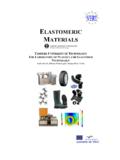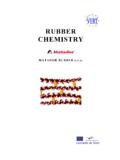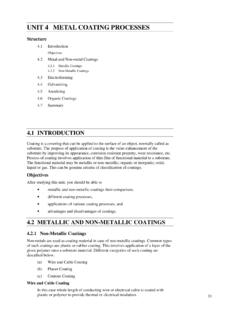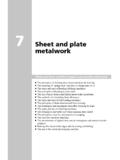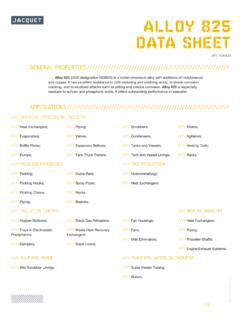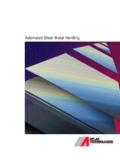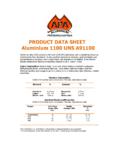Transcription of PROCESSING OF ELASTOMERIC MATERIALS - HEM
1 PROCESSING OF. ELASTOMERIC . MATERIALS . L ROVERKET AB. Summary We welcome students to a module where PROCESSING methods of ELASTOMERIC MATERIALS are discussed. Starting off with the mixing process of raw MATERIALS and continuing to describe all the different PROCESSING methods used to produce rubber products. Everything described for cured rubber as well as for thermoplastic elastomers. Students may very well choose to study the module separately as an introduction to rubber technology and benefit from the fact that there is included a short description of polymers used in the rubber industry. The module deals with the following PROCESSING techniques of ELASTOMERIC MATERIALS . Main chapters: Mixing Mould curing Textile treatment Rubber-metal bonding Calandering Vulcanisation Spreading Latex processes Extrusion Urethane rubber Mixing In the mixing process an uncured compound is manufactured in order to be used for further PROCESSING into a rubber product.
2 Textile treatment Reinforcing material has to be treated to obtain dimension stabilized products with good bonding between rubber and the reinforcing material. Calandering An important process to make flat sheeting, rubber coated fabrics as uncured products or as semi product parts. Spreading A technique for manufacturing thin rubber coated fabrics. Extrusion A technique for manufacturing long length products e g tubes or profiles which can be cured to final products or be used as parts in confectioned rubber products. Mould curing Main technologies for moulding rubber are compression, transfer and injection moulding and methods for post- PROCESSING of cured products. Rubber-metal bonding To achieve a good bonding between rubber and metal, the metal has to be degreased and treated with bonding agents before moulding or autoclave curing. L roverket AB 2007 2. Vulcanization All different curing methods used to cure products shaped by the processes mentioned above.
3 Latex processes The processes used for manufacturing of products from liquid rubber latex in contrast to the methods presented above, where dry rubber is used. Urethane rubber A presentation of the special processes used for manufacturing of products from liquid urethane rubber. Thermoplastic elastomers The following PROCESSING methods for thermoplastic elastomers are discussed;. injection moulding, extrusion and some techniques for melt calandering and blow moulding. Facts of PROCESSING methods The choice of different PROCESSING methods and the economical view on techniques and qualities aspects are dealt with in this chapter. Environment and recycled rubber Finally the student will find a chapter dealing with environment matters and the methods of recycling of rubber. After studying this module, the student has obtained a good overview and knowledge of different PROCESSING methods used for producing all kinds of products manufactured of cured rubber or thermoplastic elastomers.
4 The student will also be able to choose a suitable technique that will optimize costs and quality. L roverket AB 2007 3. Table of contents Table of 1. Introduction to PROCESSING of rubber Special features of the PROCESSING of 2. Rubber, a short description of History of The discovery of Rubber Classifications, different types of General purpose Special purpose Speciality elastomers ..14. Terminology ..14. Properties ..15. MATERIALS ..19. What is a Polymer?..21. Field of applications ..23. 3. Thermoplastic Classification ..25. Properties ..27. Field of application ..28. 4. PROCESSING methods for rubber Raw MATERIALS ..29. Equipments ..32. Mixing techniques ..35. PROCESSING Batch Textile Reinforcing Treatment for textile adhesion ..42. Hot Machinery ..48. Peripherial Sheet preparation ..52. Rubber L roverket AB 2007 4. Spreading ..54. Solution of rubber compound ..56. Spreading Spreading process ..58. Machinery.
5 59. Die manufacturing ..62. Mould curing ..65. Machinery ..66. PROCESSING problems ..72. Post- PROCESSING ..74. Moulds ..76. Rubber-metal bonding ..78. Bond system Adhesion ..84. Flow chart ..91. Levels of adhesion ..91. Vulcanisation ..93. Autoclave Non-pressurized Continuous Continuous curing of Continuous curing of cables ..100. Continuous curing of calendered products ..100. Radiation Latex Dipping ..105. Other Urethane rubber ..108. Casting Injection 5. PROCESSING methods for thermoplastic Injection Other 6. Facts of PROCESSING Choices from different methods ..119. Cost aspects ..121. Process L roverket AB 2007 5. 7. Environment ..125. Health and safety ..135. Recycled rubber ..138. L roverket AB 2007 6. Introduction Like the rubber MATERIALS , the PROCESSING of rubber has a long history. The history goes back to the beginning of the 1820's. In England Thomas Hancock manufactured a machine for the mastication of natural rubber in order to achieve a consistency of material that could improve its process ability, this procedure is mastication and the technique is still valid.
6 The rubber polymers are high molecular weight MATERIALS , arranged in long chains and the PROCESSING is intended to mix rubber with particulate fillers, mostly consisting of very hard particles such as carbon black, silica as well as liquid softeners. Most of the methods to process rubber MATERIALS require energy-consuming machinery operating under severe conditions. The rubber production can be divided into two basic steps. The first step consists of mixing, calendering and coating of fabrics. This step can be considered as a physical PROCESSING industry. Long runs of production are often most economically competitive and they make it possible to invest in advanced technical equipment and systems for process control. In this area of production semi finished products are manufactured for further PROCESSING to final products. There are several methods and processes that aim to manufacture final products such as mould curing, extrusion or assembly of preshaped MATERIALS .
7 This part of the rubber industry can be referred to as engineering industries where computerized and automated processes are dominating. Manufacture of tyres is an excellent example showing this division in a PROCESSING part and a highly automated engineering manufacturing part. However, a skill of craftsmanship is still a substantial and very important part if rubber production. By combining the many unique qualities that rubber material possesses with the craftsmanship maintained through more than a hundred years and constantly developed, modern techniques can be used for long line productions as well as for handmade special products. The course aims to give the student a broad and in some parts deeper knowledge of different types of PROCESSING of rubber MATERIALS and thermoplastic elastomers with the results that the student after accomplished the course will: possess special knowledge as regarding processes of rubber and thermoplastic elastomers be able to assist in the mixing process be able to participate in the development process of existing and new processes and products in which rubber and thermoplastic elastomers makes an important part be able to solve rubber PROCESSING and manufacturing problems L roverket AB 2007 7.
8 1. Introduction to PROCESSING of rubber MATERIALS Overview of polymers, elastomers and plastics The picture Overview of polymers, elastomers and thermoplastics shows that the elastomers are divided in one cross-linked (cured) group of MATERIALS rubber - and one thermoplastic group - thermoplastic elastomers. Due to this difference the two groups of elastomers require different processes even if the properties of the ready products to some extend are comparable. Rubber A compound is mixed of the polymer, fillers, softeners, curatives and other additives. (link to Raw MATERIALS and Compounds). The compound used are: o either preformed by calendering, coating on a fabric or by extrusion to become a component in a final product o or by calendering or extrusion given the right shape for the final product o or for filling the cavity in a mould. For many products like tyres, hoses and belts the preformed parts have to be assembled to the shape of the final product.
9 The product is then cured at a temperature of 140 - 200 C to receive its requested final properties. Through the curing which is the crosslinking process, the rubber compound properties are changed from a plastic to an elastic state. In some cases the curing is done online at the same time as the forming of the product for extruded products like sealing profiles and cables. The cured product may in some cases pass a post-process post-curing or surface treatment. Finally a quality control operation is done. L roverket AB 2007 8. Thermoplastic elastomers The material is normally supplied ready mixed directly from the raw material supplier. The shaping of the products is done by heating the material to a temperature above the melting point. After the forming process the product is cooled to room temperature. That is when the material will receive its properties. The main processes used are: o Calendering o Extrusion o Moulding by injection in a cavity The final product has to pass a quality control operation.
10 Special features of the PROCESSING of rubber The PROCESSING properties are highly depended on the composition of the rubber compound. To achieve the expected properties of a product a proper mixing procedure is essential. The final properties for the rubber product is achieved when the curing process is taking place at a temperature of normally 140 200 C whereby the rubber is cross-linked and obtains its elastic state. The elastomer and hence the compound is viscous, therefore PROCESSING ( extrusion or moulding) of the uncured compound is improved at elevated temperature. The PROCESSING temperature often goes up to 100 - 110 C and is thereby coming close to the curing temperature. The compound must be compounded so that scorching (start of curing reaction). will not start at the PROCESSING temperatures. At the same time the curing reaction being depended on time and temperature - must be as fast as possible to admit short curing time and contribute to a high productivity.
